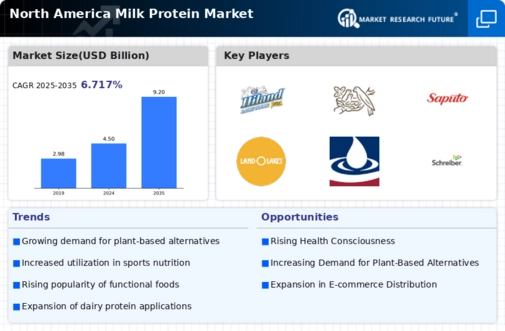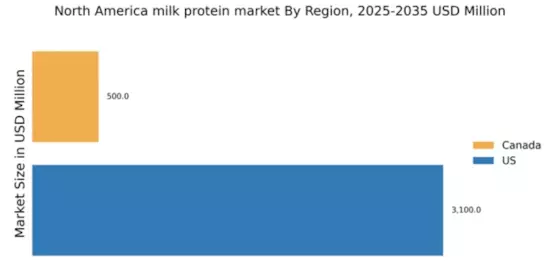Health Consciousness Among Consumers
The increasing health consciousness among consumers in North America appears to be a primary driver for the milk protein market. As individuals become more aware of the benefits of protein for muscle maintenance and overall health, the demand for protein-enriched products rises. According to recent data, the protein intake recommendations have led to a surge in the consumption of milk protein, which is perceived as a high-quality source. This trend is particularly evident among fitness enthusiasts and health-conscious individuals, who are actively seeking products that support their dietary needs. The milk protein market is likely to benefit from this growing awareness, as consumers prioritize nutritional value in their food choices.
Growth of the Sports Nutrition Sector
The expansion of the sports nutrition sector in North America significantly influences the milk protein market. With a growing number of individuals engaging in fitness activities, the demand for protein supplements and functional foods has surged. The sports nutrition market is projected to reach approximately $45 billion by 2026, indicating a robust growth trajectory. Milk protein, known for its rich amino acid profile, is increasingly incorporated into various sports nutrition products, including protein powders and bars. This trend suggests that the milk protein market is well-positioned to capitalize on the rising interest in sports nutrition, as consumers seek effective ways to enhance their performance and recovery.
Regulatory Support for Dairy Products
Regulatory support for dairy products in North America is a significant driver for the milk protein market. Government initiatives aimed at promoting dairy consumption, particularly among children and adolescents, contribute to a favorable environment for the milk protein market. Programs that encourage the inclusion of dairy in school meals and nutritional guidelines that emphasize the importance of protein intake are likely to bolster demand. Additionally, the establishment of standards for milk protein content in various products ensures quality and safety, further enhancing consumer trust. This regulatory framework may provide a stable foundation for growth in the milk protein market, as it aligns with public health objectives.
Innovation in Dairy Processing Technologies
Advancements in dairy processing technologies are likely to play a crucial role in shaping the milk protein market. Innovative techniques such as microfiltration and ultrafiltration enable the extraction of high-quality milk proteins while preserving their functional properties. These technologies not only enhance the nutritional profile of dairy products but also improve their sensory attributes, making them more appealing to consumers. As the milk protein market embraces these innovations, it may witness an increase in product offerings that cater to diverse consumer preferences, including lactose-free and low-fat options. This adaptability could potentially drive market growth as manufacturers respond to evolving consumer demands.
Rising Popularity of Plant-Based Alternatives
The rising popularity of plant-based alternatives in North America presents both challenges and opportunities for the milk protein market. While the demand for plant-based proteins is increasing, many consumers still seek the nutritional benefits of dairy proteins. This duality suggests that the milk protein market may need to adapt by highlighting the unique advantages of milk proteins, such as their complete amino acid profile and bioavailability. Furthermore, some manufacturers are exploring hybrid products that combine milk proteins with plant-based ingredients, potentially appealing to a broader audience. This trend indicates a dynamic market landscape where innovation and consumer preferences will shape future growth.


















Leave a Comment